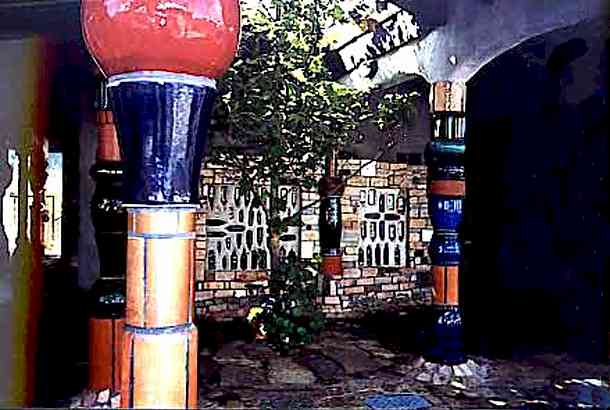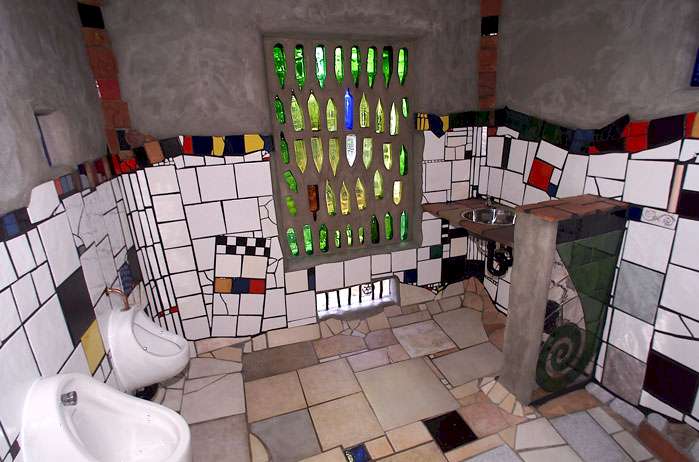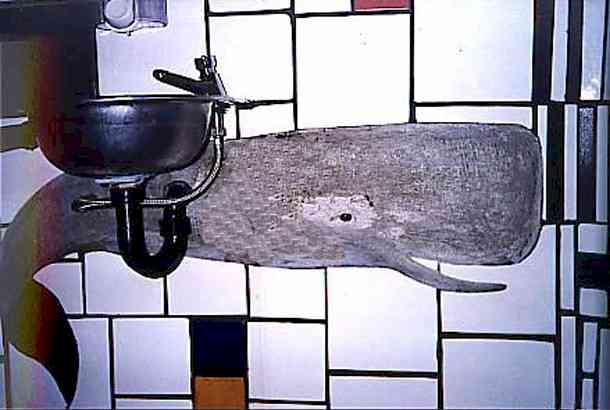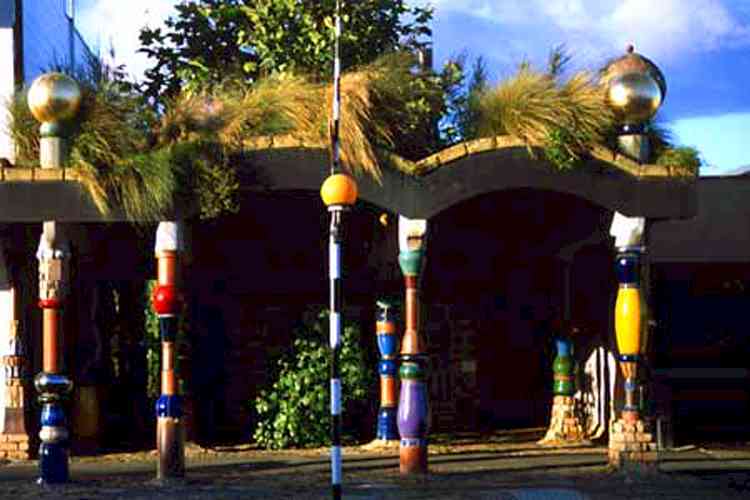To Toil Et Art
Hundertwasser's Ultimate StandPsychiatry's chief contribution to philosophy is the discovery that the toilet is the seat of the soul. - Alexander Chase
The KawaKawa Public Toilets: photo by Tessa Laird Internationally renown artist and architect Frederick Hundertwasser could never have dreamed of the impact he was going to have on a small, rural community when he made New Zealand his second home 25 years ago. From a sleepy hollow just off the tourist track through the Bay of Islands, the Kawakawa township has burgeoned into a "must see" mecca for Hundertwasser devotees worldwide. It all happened as a result of a public toilet - probably the most unlikely building to have ever captured international visitor attention anywhere. The project has already attracted both French and Japanese television documentary teams to Kawakawa, together with international visitors already beginning to number in the thousands. Bus tours pull up outside for photo sessions, travelers familiar with Hundertwasser's work in Europe are making special visits to the Bay of Islands rural township, and domestic visitors are making a stopover for both practical and philosophical reasons. Already there are clear indications of an economic impact in the small town's retail sector.
Frederick Hundertwasser first visited New Zealand in the 1970's to mount a public exhibition of his work. He was so captured by the country that he resolved to make it his second home, purchasing an isolated rural property on the Waikino peninsula on the Waikare Inlet east of the Kawakawa. Initially he was to spend only a few months of each year in the Bay of Islands, with the majority of his time still spent in Europe - Vienna in particular. But in recent years Hundertwasser spent more and more time at his New Zealand home. He loved the informality of the area and the freedom to walk the streets of the Kawakawa township anonymously. He felt for the town and its entrapment in the rural decline which so much of New Zealand had suffered. In 1998 the Kawakawa Community Board was looking to upgrade 40-year-old toilet facilities in the central township, and Hundertwasser offered a solution from his design palate. His concept was adopted and construction was completed early this year, with the artist personally lending a hand in construction supervision, including the provision of materials from his own studio. Hundertwasser was in fact more involved in construction than he was in the world-renown Hundertwasser House apartments project in Vienna.
Apart from the Koru flag he designed in 1983 as an alternative standard for Aotearoa, In consultation with the Bay of Islands College, students prepared ceramic tiles which have been used throughout the building. The bricks used came from a former Bank of New Zealand building, and both young and old from the local community volunteered services to the construction process. The finished product is a work of art, from the grass roof, to gold balls, ceramic tiles, bottle glass windows, mosaic tiling, copper handwork, cobblestone flooring, individual sculptures and a living tree integrated into the design structure. With the untimely death of the Austrian-born artist in February 2000, the building is the only Hundertwasser structure in the Southern Hemisphere, and the last major project ever undertaken by the famous artist and designer. It will remain as both a memorial to Frederick Hundertwasser and a very functional building for the community and visitors alike. So impressive has been the final result that Creative New Zealand gave the project the "premier" certificate in the Creative Places Awards 2000 contest. The results were announced at the Local Government New Zealand conference at Christchurch earlier this year. In making the award Creative New Zealand chairperson Peter Biggs said: "This project was initiated by a rural community in a district that has faced many challenges. Yet the Far North has realised a magnificent, integrated project which stands out as a gleaming example to the rest of New Zealand." The Hundertwasser toilet project was also the Urban and Landscape Design category winner in the awards. The building is now arguably the most photographed "public loo" in New Zealand, and possibly in the world. Source: fndc.govt.nz/toilets/ihunderwasser Far North District Council Hundertwasser Toilet Information Page
Watch on Landmark Loo
Source: Was home.t-online.de/home/o.l.b.creatix/nz_01_j.html, by Bridget Carter Security will be increased at the famous Hundertwasser toilet block in Kawakawa to deter vandals. The organic-style toilets by the late Viennese artist Frederick Hundertwasser will have security lights installed front and back within the month. Cameras will be connected to the neighbouring council building at the back of the toilet block and at the entrance of both the men's and women's toilets. Richard Smart, who worked with Hundertwasser for eight years, said vandalism was a continuing problem. So far there had been only minor damage. "Hopefully, these cameras will slow people down." Kawakawa's rundown 1960s toilet block was transformed by Hundertwasser, a Northland resident, in 1999. The toilets show his trademark "organic" architecture of curved lines and a grassy roof. They have ceramic pillars, gold domes and windows using old wine bottles to filter light.
Source: photos.travelog.org Hundertwasser is best known for his first building, Hundertwasser House, in Vienna, which attracts more than a million visitors each year. He donated his design for the toilet block because he liked Kawakawa and the anonymity it provided. "He was just another person there," said Mr Smart. Kawakawa was then a dying town and it was feared the toilets would be trashed. But Hundertwasser believed that if you created something good, people would feel proud and would not act aggressively. Children from schools in the district made tiles for the building because he believed that involving the community in a project gave it a sense of ownership. "Generally, the building has been well respected by the locals," Mr Smart said. Some of the bottles were smashed a few months ago, but were easily replaced. Noma Shepherd, chairwoman of the Kawakawa Community Board, said the toilets received less graffiti than other structures in the town. Source: nzherald.co.nz 27 July 2002 See also:
For photos of the earth and moon, stained glass, sunsets on the Wellington Harbour, Lady Fair, Civic Square, the old mill, the Whippany River, historical houses, Lake Parsippany and more clicking
the "Up" button below takes you to the Index page for this Photographs section. |
 Animals
Animals Animation
Animation Art of Playing Cards
Art of Playing Cards Drugs
Drugs Education
Education Environment
Environment Flying
Flying History
History Humour
Humour Immigration
Immigration Info/Tech
Info/Tech Intellectual/Entertaining
Intellectual/Entertaining Lifestyles
Lifestyles Men
Men Money/Politics/Law
Money/Politics/Law New Jersey
New Jersey Odds and Oddities
Odds and Oddities Older & Under
Older & Under Photography
Photography Prisons
Prisons Relationships
Relationships Science
Science Social/Cultural
Social/Cultural Terrorism
Terrorism Wellington
Wellington Working
Working Zero Return Investment
Zero Return Investment



